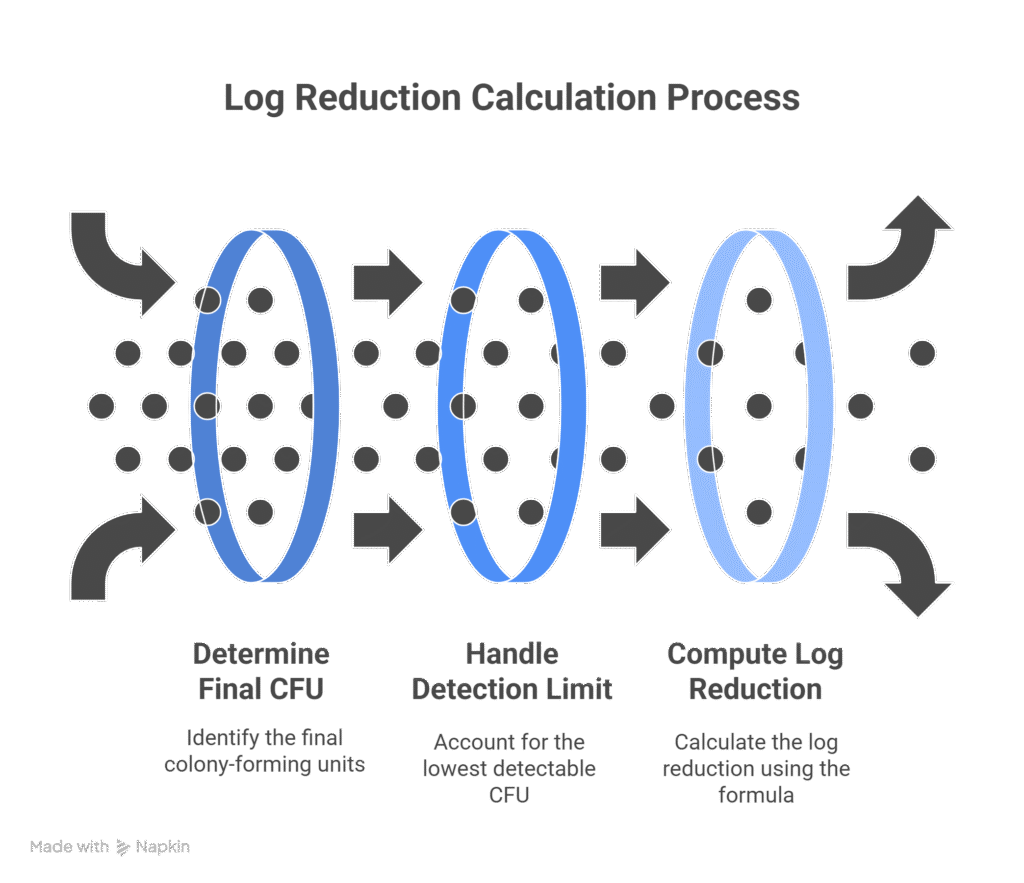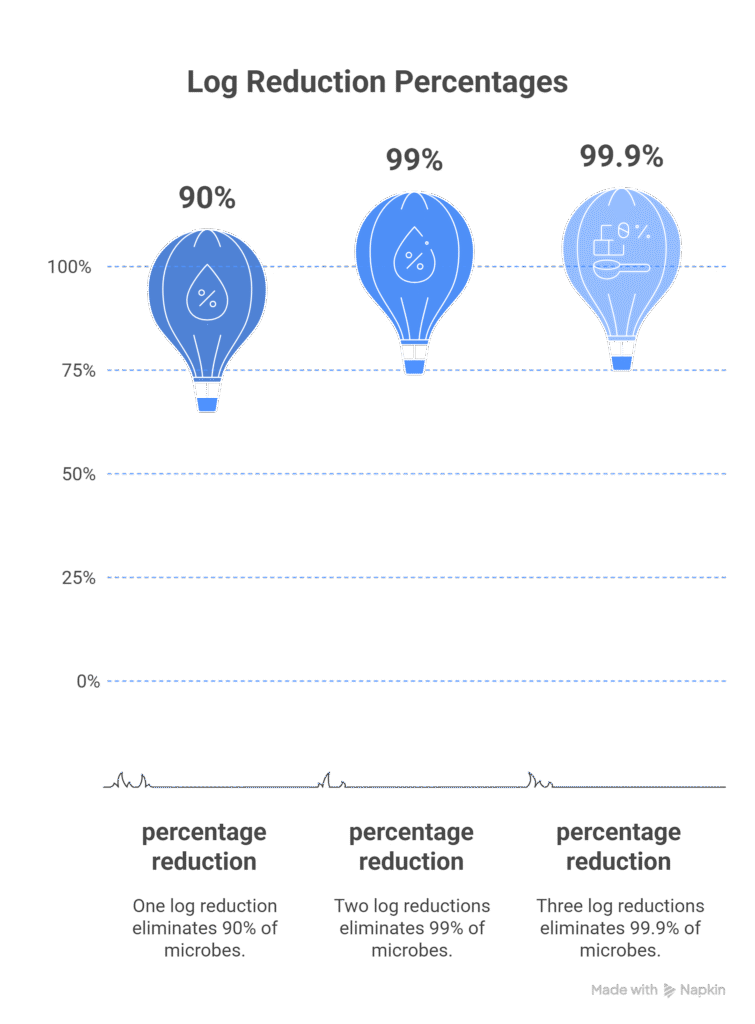Log Reduction Calculator
Calculate microbial log reduction, survival rates, and inactivation efficacy for sterilization and disinfection processes.
Colony Forming Units before treatment
Colony Forming Units after treatment
Log Reduction Results
Efficacy Scale
Survival Rate Results
Practical Implications
Treatment Efficacy
Microorganism Resistance
How to Use This Calculator
- Enter the initial microbial population before treatment
- Enter the final microbial population after treatment
- Click “Calculate Log Reduction” to see results
- View your result on the efficacy scale
- Enter the log reduction value achieved
- Enter the initial microbial count
- Click “Calculate Survival Rate” to see results
- Review practical implications of the survival rate
- Select the type of microorganism
- Choose the treatment method used
- Enter the treatment duration
- Click “Calculate Efficacy” to see expected results
Key Formulas
Log Reduction
LR = log10(N0) – log10(N)
Where N0 is initial count, N is final count
Percent Reduction
% Reduction = 100 × (1 – 10-LR)
Example: 3-log reduction = 99.9% reduction
Survival Rate
Survival = N0 × 10-LR
Number of microorganisms surviving treatment
Log Reduction Standards
| Log Reduction | Percent Reduction | Reduction Factor | Common Applications |
|---|---|---|---|
| 1-log | 90% | 10× | Basic cleaning, hand washing |
| 2-log | 99% | 100× | Surface disinfection |
| 3-log | 99.9% | 1,000× | Food pasteurization |
| 4-log | 99.99% | 10,000× | Medical device disinfection |
| 5-log | 99.999% | 100,000× | Sterilization, water treatment |
| 6-log | 99.9999% | 1,000,000× | Sterile pharmaceuticals |
Microorganism Resistance Hierarchy
Industry Standards
- FDA Food Code: 5-log reduction for juice pasteurization
- CDC Guidelines: 6-log reduction for high-level disinfection
- Pharmaceuticals: Sterility assurance level of 10⁻⁶ (6-log)
- Water Treatment: 4-log reduction for viruses and bacteria
- Medical Devices: SAL 10⁻⁶ for sterile products
Applications
- Food safety and pasteurization validation
- Pharmaceutical sterilization processes
- Water treatment efficacy testing
- Medical device disinfection protocols
- Surface disinfection validation
- Antimicrobial product testing



Log Reduction Calculator — Measure Disinfectant & Sterilization Efficacy
Log reduction is a widely used metric in microbiology, environmental safety, and hygiene to express how much a microbial population is reduced by a treatment. Whether you’re evaluating disinfectants, validating filters, or ensuring food safety, accurate log reduction calculation matters. This page helps you use a log reduction calculator properly, understand methods, avoid common mistakes, and interpret your results in real-world settings.
What Is Log Reduction & Why It’s Important
Log reduction expresses the effectiveness of a decontamination process by comparing the microbial count before treatment (initial CFU) to the count after treatment (final CFU), using base-10 logarithms. Wikipedia+2Omni Calculator+2
- 1-log reduction means 90% of microbes eliminated,
- 2-log → 99%,
- 3-log → 99.9%, and so on. Wikipedia+1
- Regulated disinfection and sterilization steps often require specific log reductions (e.g. >5 log, >6 log) to meet safety & regulatory standards. Aqua Free
How the Calculator Works — Formula & Inputs
The core formula:
Log reduction = log10 (Initial count / Final count)
Additionally, percentage reduction is:
% Reduction = (Initial − Final) / Initial × 100%
Required inputs:
- Initial count (e.g. CFU/mL or CFU on surface)
- Final count after treatment
- Optionally, detection limit (if final count is below detection, often treated as zero)
- If applicable, volume or surface area to normalize results
Calculator features should include:
- Ability to compute missing variable if log reduction + one count known
- Handling final = 0 or “below detection limit” cases
- Showing both log and % results
Real-World Use Cases & Standards
- Healthcare / Sterilization: Validating disinfectants used in hospitals, surgical instrument sterilization with required log reductions (e.g. 5-log or more).
- Water Treatment & Filtration: Ensuring drinking water meets microbial safety (e.g. 4-log reduction for certain bacteria or pathogen removal). Aqua Free+2Crystal IS+2
- Food & Beverage Industry / Sanitation: Disinfecting surfaces, equipment; regulatory compliance requires specific log reductions.
- Laboratory Testing / QA: Comparing disinfectants, devices, sterilization cycles using CFU counts & log reduction metrics.
Best Practices & Common Pitfalls
| Potential Pitfall | Why It May Lead to Error | How to Avoid It |
|---|---|---|
| Using final CFU=0 without accounting for detection limits | Log becomes infinite or undefined | Indicate “< detection limit”; use conservative estimates |
| Counting errors (plating, samples, dilution) | Skewed initial or final counts distort log result | Use replicates; standard methods for CFU counting |
| Not normalizing for volume or surface | “Initial” and “final” counts may not be comparable | Always define and adjust for units (CFU/mL, CFU per cm²) |
| Overlooking regulatory definitions | Different agencies require different log levels | Refer to EPA, FDA, ASTM or local guidelines |
FAQ
- What happens if final CFU is zero?
Use the detection limit or the smallest quantifiable count; many calculators allow “< X” inputs. - Can log reductions from multiple steps be added?
Yes – if independent and sequential, log reductions are additive (e.g. 2 log from step 1 + 3 log from step 2 = 5 log overall) provided no carryover. - How does detection limit affect log reduction?
If final count is below detection, you report “at least X-log reduction” using detection limit as proxy. - What log reduction is considered “good”?
It depends on use case:
• 1-2 log may be minimal for mild disinfectants
• 4-5 log typical for strong disinfectants / sterilization
• 6-log or more for critical sterilization especially for medical tools or viral clearance standards.
Regulatory & Industry Standards
- EPA & AOAC define required log reductions in disinfectant efficacy reports.
- ASTM F838 for filter validation and log reduction claims. Aqua Free
- Hospital accreditation bodies often require validated disinfection cycles with documented log reduction thresholds.
Summary
A good Log Reduction Calculator is more than a simple tool—it should embody clarity, accuracy, lab best practices, and regulatory awareness. By including clear formula explanations, real-world use cases, standards, and handling of edge conditions, your page will offer superior value, stronger EEAT signals, and more semantic depth that both users and search engines favor.
